n When William Kent married Elizabeth Lynes in 1756, itnseemed that he was about to change his former ways. Kent had been a usurer innNorwich, lending money at high interest, but after his marriage he took, first,nan inn and then a post office in nearby Stoke Ferry, Norfolk. Soon, Elizabeth becamenpregnant with their first child and the couple were, by all accounts, happilynmarried and very much in love.
n
n
n
nThis domestic idyll was brought to a tragic endnwhen Elizabeth died during childbirth but her sister, Frances, who had earliernmoved in to help with the birth, stayed on with Kent and the infant boy, actingnas their housekeeper. Kent and Frances, or Fanny as she was known, fell in lovenbut because the child had been born alive, canon law at the time forbade themnfrom marrying, even though the baby had only survived his mother by a fewnhours.
n
n
n
 |
| London – Cock Lane marked in red |
n
n
n
nKent moved to London, hoping that hard work would help him overcome hisngrief, but Fanny, her absent heart growing ever fonder, wrote numerous passionatenlove letters to him, and she eventually moved to London to be with him. Thenpair lived as man and wife, hiding their illicit relationship in the anonymitynof the capital, and they even drew up mutual wills in the other’s favour. ThenLynes family disapproved and frequently intervened, exposing the couple’snsituation to their landlords and forcing them to move lodgings, until at lastnthey met a sympathetic church clerk called Richard Parsons, who offered them anroom in his house in Cock Lane, near Smithfields meat market.
n
n
n
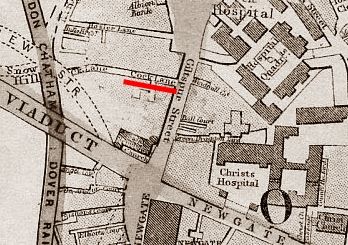 |
| Close-up of the above map |
n
n
n
nIt was a tiny house,njust three single rooms, one on each floor, with a winding staircase betweennthem, in a once-respectable but by then declining area of London. Parsonsnhimself was also in decline, outwardly respectable but far too fond of drink,nhe was struggling to provide for his family, and he borrowed twelve guineasnfrom Kent, to be repaid at the rate of a guinea a month. Fanny was, by then,nheavily pregnant, and when William Kent went to attend a wedding in thencountry, he asked if Parsons’ ten-year-old daughter would stay with Fanny inntheir room.
n
n
n
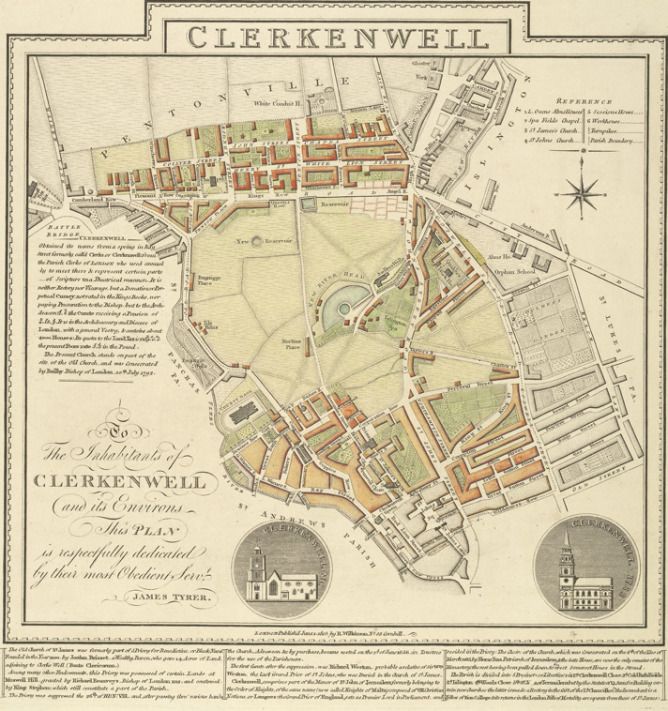 |
| Clerkenwell |
n
n
n
nOn his return, he found Fanny was ill and, following an argumentnwith Parsons about money, in January 1760, Kent moved Fanny to more suitablenaccommodation in Bartlett Court, Clerkenwell. A doctor was called for, who seemednsure that the baby was about to be born, but as her condition worsened, hendiagnosed a virulent form of smallpox and told Kent to prepare for the worst.nOn February 2nd, after having had her will confirmed as legal by ansolicitor, Fanny died and her body was buried in an unmarked coffin, in thenvaults of St John’s Clerkenwell.
n
n
n
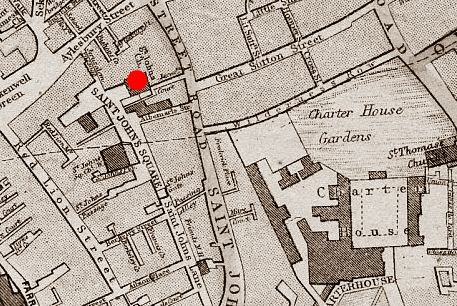 |
| Clerkenwell – St John’s marked in red |
n
n
n
nKent was unwilling to put his own name on thencoffin, lest that be seen as illegal, and was unwilling to put any other namenon the casket. He informed Fanny’s sister, Ann, who lived in Pall Mall, of thendeath and she attended the funeral, after which Kent offered whichever ofnFanny’s clothing she wanted but Ann declined, adding that she had regarded Kentnand Fanny as a married couple in all but name. However, when Fanny’s will was madenpublic, the Lynes family were shocked to learn that their sister had left eachnof them half a crown with the rest of her estate going to Kent. It wasn’t much,njust over a hundred pounds, and Kent’s own fortune amounted to many times thatnamount but still the Lynes felt hard done by and took the case to court, whichnfound in Kent’s favour, causing more resentment from the family. It seemed thatnthat was the end of the matter – Kent remarried the following year and took anjob as a stockbroker in London, and sued Parsons for the outstanding debt.
n
n
n
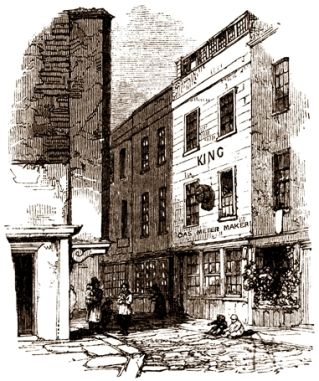 |
| The House in Cock Lane |
n
n
n
nThen, in January 1762, a report appeared in the London Ledger that anghostly disturbance had occurred in Cock Lane, at the house of the clerk of StnSepulchre’s, and an investigation by four gentlemen, including a clergyman, hadnrevealed that the noisy spirit had rapped thirty-one times when asked if anyonenhad been poisoned in the house. Reports from the neighbourhood said that anwoman had been poisoned by her brother-in-law and that her body had beenninterred in St John’s Clerkenwell. Other London newspapers took up the matternduring the next fortnight, although any of the names of those involved werenredacted and they were referred to only by their initials. These accounts toldnthe story that the ghostly rappings had first occurred two years before, whennthe dead woman was still alive and had shared her room with the clerk’s youngndaughter when her husband was away at a wedding.
n
n
n
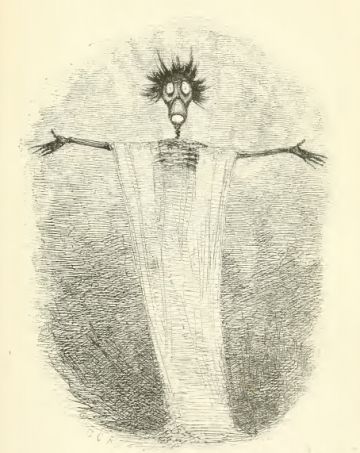 |
| The Ghost |
n
n
n
nThere had been knockings andnscratchings, a ghostly figure in white had been seen on the staircase bynseveral people, and the woman became convinced that it was the spirit of herndead sister, come to warn her of her own impending murder. Aided by John Moore,nformer assistant preacher at St Sepulchre’s and now rector at StnBartholemew-the-Great, Smithfield, Richard Parsons set about investigating hisndaughter Elizabeth’s bedroom, as the sounds occurred when only Elizabeth, nownaged twelve, was present.
n
n
n
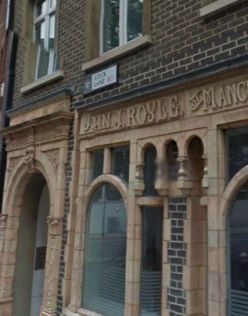 |
| Modern Cock Lane |
n
n
n
nNoises like the scratching of a cat on a cane chairnwere heard, and when questions were put to the ghost, replies were made by onenknock for ‘yes’ and two knocks for ‘no’. Understandably, when William Kentnheard about this, he made straight for Cock Lane and took part in one of thenséances. Things did not go well.
n
n
n
n“Are you Miss Fanny ?” ‘One knock – Yes.’n
n‘Did you die naturally?’ ‘Two knocks – No.’n
n‘Did you die bynpoison?’ ‘One knock – Yes.’n
n‘Do you know what kind of poison itnwas?’ ‘One knock – Yes.’n
n‘Was it arsenic?’ ‘One knock – Yes.’n
n‘Was it given to you by any person other than Mr. Kent?’ ‘Two knocks – No.’n
n‘Do you wish that he be hanged?’ ‘One knock – Yes.’n
n‘Was itngiven to you in gruel?’ ‘Two knocks – No.’n
n‘In beer?’ ‘Onenknock – Yes.’n
n(Here a spectator interrupted with the remark that thendeceased was never known to drink beer, but had been fond of purl, [a mix ofnale and gin] and the question was hastily put.)n
n‘Was it not in purl?’n‘One knock – Yes.’n
n‘How long did you live after taking it?’ ‘Three knocks, held to mean three hours.’n
n‘DidnCarrots (her maid) know of your being poisoned?’ ‘One knock – Yes.’n
n‘Did you tell her?’ ‘One knock – Yes.’n
n‘How long was it afternyou took it before you told her?’ ‘One knock, for one hour.’n
nKent, by nownoutraged, cried out,n
n“Thou art a lying spirit, thou are not the ghost of mynFanny. She would never have said any such thing.”n
nn
n
n
nTomorrow – Scratching Fanny in Cock Lane
n
n
n
n
n
n



















